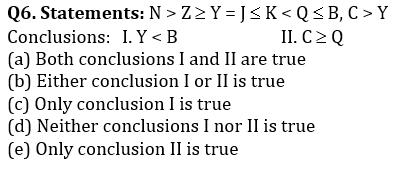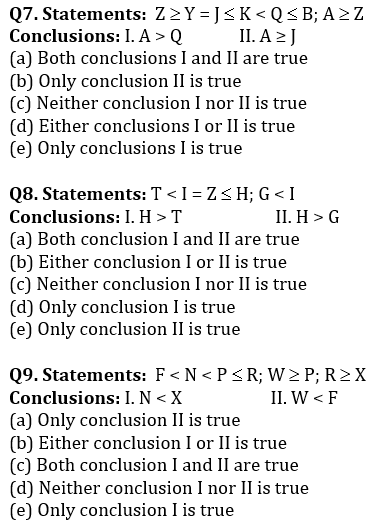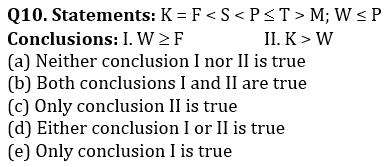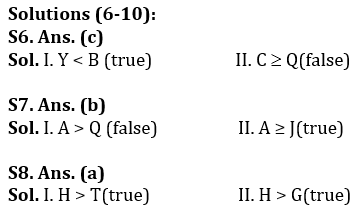Directions (1-5): In these questions, relationship between different elements is shown in the statements. The statements are followed by conclusions. Study the conclusions based on the given statements and select the appropriate answer. Give answer-
(a) If only conclusion I is true
(b) If only conclusion II is true
(c) If both conclusions I and II are true.
(d) If either conclusion I or II is true
(e) If neither conclusion I nor II is true.
Q1. Statements: K<Q≤J, B<O=N, O>M<I=Q.
Conclusions: I. B<I
II. O≤B
Q2. Statements: A≥C≤Z< Y, O=M <Z > X
Conclusions: I. Y>X
II. M> C
Q3. Statements: Z>Y≥R, Y≤J>K, J=O>Q
Conclusions: I. Q>Y
II. Z>O
Q4. Statements: K<Q, N≤J≥M, Q<O=N
Conclusions: I. N<M
II. N>M
Q5. Statements: J>K<L<R<L>T<Z
Conclusions: I. K < T
II. T ≤ K
Directions (6-10): In these questions, relationship between different elements is show in the statements. The statements are followed by conclusions. Study the conclusions based on the given statements and select the appropriate answer:



Q11. In which of the following expression shows that, ‘M≥O’ and ‘Z<Y’ being definitely true?
(a) M>O>B≥Z≥E<Y
(b) Z<Q≤Y<M>J≥O
(c) Y>O≤Z≤I≤M=Q
(d) Y>I≥Z=O≤J≤M
(e) None of these
Q12. Which of the following symbols should replace the sign (?) and (*) in the given expression in order to make the expression Q>X definitely false and Z>Q is definitely true?
Z (?) Y > Q (*) M ≥ X
(a) >, >
(b) ≥, >
(c) <, =
(d) >, =
(e) None of these
Q13. Which of the following symbols should replace the sign (?) and (#) in the given expression in order to make the expressions A≥Y definitely true and K<P definitely false?
K < M ? A = P # Q ≥ Y
(a) ≥, >
(b) <, >
(c) >, ≥
(d) =, >
(e) None of these
Q14. Which of the following symbols should replace the sign (%) and (@) in the given expression in order to make the expressions X<M and R≥Z definitely true?
P > M ≥ Q % Z = X @ R
(a) ≥, >
(b) ≥, ≤
(c) >, ≤
(d) =, ≥
(e) None of these
Q15. Which of the following expression will be definitely false if the expression
‘A ≤ R < C = D ≥ E > B’ is definitely true?
(a) C > A
(b) D > B
(c) B > C
(d) E ≤ C
(e) None is false
Solutions
Solutions (1-5):
S1. Ans. (e)
S2. Ans. (a)
S3. Ans. (e)
S4. Ans. (e)
S5. Ans. (d)


S11. Ans. (d)
S12. Ans. (d)
S13. Ans. (c)
Sol. K < M > A = P ≥ Q ≥ Y
S14. Ans. (c)
Sol. P > M ≥ Q > Z = X ≤ R
S15. Ans. (c)





 GA Capsule for SBI Clerk Mains 2025, Dow...
GA Capsule for SBI Clerk Mains 2025, Dow...
 The Hindu Review October 2022: Download ...
The Hindu Review October 2022: Download ...
 ECGC PO Scorecard 2025 Out, Check Marks
ECGC PO Scorecard 2025 Out, Check Marks




